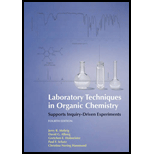
Interpretation:
The type of glassware that would be most appropriate for reaction of
Concept introduction:
Laboratory glasswares are the types of equipment that are made up of glass and are utilized for scientific work in the laboratories. The glassware is used in the laboratories because of their low coefficient of expansion and high resistance to chemical attack. Ground glass joints are one of the types of glassware utilized in laboratories to easily fit into leak-tight apparatus from commonly available parts.
Microscale and miniscale glassware are two important types of glassware used for the reaction that use a small amount of the reactants.
Explanation of Solution
The microscale glassware is the glassware used for the reactions that use very small amounts of material nearly
Therefore, the reaction of the
The reaction of
Want to see more full solutions like this?
Chapter 4 Solutions
Laboratory Techniques in Organic Chemistry
- what is the role of methanol for extracting chlorophyll? What molecular force holds your chlorophyll and solvent together?arrow_forward$4/34) 2. Reduction of ethyl acetoacetate with sodium borohydride (3:38-5:32). a. In setting up the reaction described in the video you add 0.127 mL of ethyl acetoacetate, 5 mL of ethanol and 74 mg of sodium borohydride. Question #1: Which compound is the limiting reagent in this reaction? Question #2: What is the theoretical yield in this reaction? Question #3: What is the % yield if you isolated 89 mg of product?arrow_forwardBox the functional group/s that contribute to the solubility (hydrophilic and lipophilic) of the given organic molecules then check whether the drug molecule is hydrophilic or lipophilic.arrow_forward
- What will happen to Dichloromethane when it is added to Silver nitrate? Does it gives a postive solution? Give an inference whyarrow_forwardwhat chemical equation produce when 5 mL of concentrated hydrochloric acid and 3 drops of 2% furfural solution are added into the test tube containing a small quantity of melted desi ghee?arrow_forward22. Calculate the corresponding weights of liquefied phenol and propylene glycol needed to prepare 24 15-mL bottles of the following formula: 0.4 mL 0.5 g 2.2 g 65 mL 17 mL 100 mL Liquefied phenol Camphor Benzocaine Ethanol Propylene glycol Purified water q.s.arrow_forward
- Calculate the amount of H2O that would be lost by the incomplete dehydration of 10.0 grams of CuSO4•5H2O. CuSO4•5H2O →CuSO4•H2O+4H2O How much solid would be left in the beaker?arrow_forward1. What is the most appropriate way to dispense 1.38 g of solid sodium chloride? With a graduated cylinder With a graduated pipette OWith a spatula With a pasteur pipet 2. Steam distillation is typically used for Isolation of organic compounds with low boiling points Isolation of organic compounds with high boiling points Removing water from an organic solution Purification of inorganic mixtures O O O Oarrow_forwardHow can we predict if 1- propanol is mixed with distilled water? Are the mass and volume conserved? When you mix two gases what can we predict about the conservation of volume in this case?arrow_forward
- 12.) What is the chemical formula of the product formed from the reaction of Sample F and reagent #4? 13.) What is the chemical formula of the product formed from the reaction of Sample G and 0.1 M K2CrO4?arrow_forwardBefore combining the oil and water phases when making moisturising lotion, the emulsifiers (Glyceryl stereate and Polysorbate 80) must be dissolved in either the oil or the water phase depending on their solubility properties. Decide in which phase each or both the emulsifiers must be dissolved and What type of emulsion (o/w or w/o) will this formulation form? Give a reason for your answer.arrow_forwardMethyl benzoate can be synthesized by a Fisher Esterification reaction, and then this ester can be used as a starting material in the grignard synthesis of triphenyl carbinol. Suppose that in the synthesis of methyl benzoate, a student started with 12 grams of benzoic acid and 29.86 ml of methanol. After finishing the preparation of the ester, 7.63 grams of methylbenzoate was obtained, and the benzoic acid reacted completely. What is the percent yield of the ester? ( density methanol = 0.791 g/ml, methanol = 32.04 g/mol, methyl benzoate = 136.15 g/mol, benzoic acid = 122.12 g/mol )arrow_forward
 ChemistryChemistryISBN:9781305957404Author:Steven S. Zumdahl, Susan A. Zumdahl, Donald J. DeCostePublisher:Cengage Learning
ChemistryChemistryISBN:9781305957404Author:Steven S. Zumdahl, Susan A. Zumdahl, Donald J. DeCostePublisher:Cengage Learning ChemistryChemistryISBN:9781259911156Author:Raymond Chang Dr., Jason Overby ProfessorPublisher:McGraw-Hill Education
ChemistryChemistryISBN:9781259911156Author:Raymond Chang Dr., Jason Overby ProfessorPublisher:McGraw-Hill Education Principles of Instrumental AnalysisChemistryISBN:9781305577213Author:Douglas A. Skoog, F. James Holler, Stanley R. CrouchPublisher:Cengage Learning
Principles of Instrumental AnalysisChemistryISBN:9781305577213Author:Douglas A. Skoog, F. James Holler, Stanley R. CrouchPublisher:Cengage Learning Organic ChemistryChemistryISBN:9780078021558Author:Janice Gorzynski Smith Dr.Publisher:McGraw-Hill Education
Organic ChemistryChemistryISBN:9780078021558Author:Janice Gorzynski Smith Dr.Publisher:McGraw-Hill Education Chemistry: Principles and ReactionsChemistryISBN:9781305079373Author:William L. Masterton, Cecile N. HurleyPublisher:Cengage Learning
Chemistry: Principles and ReactionsChemistryISBN:9781305079373Author:William L. Masterton, Cecile N. HurleyPublisher:Cengage Learning Elementary Principles of Chemical Processes, Bind...ChemistryISBN:9781118431221Author:Richard M. Felder, Ronald W. Rousseau, Lisa G. BullardPublisher:WILEY
Elementary Principles of Chemical Processes, Bind...ChemistryISBN:9781118431221Author:Richard M. Felder, Ronald W. Rousseau, Lisa G. BullardPublisher:WILEY





